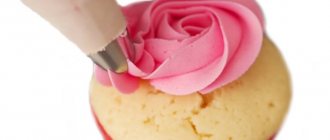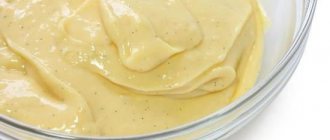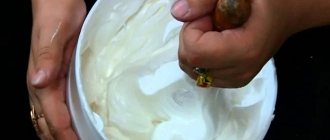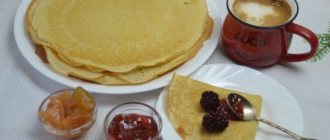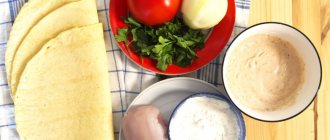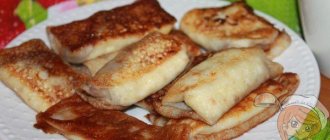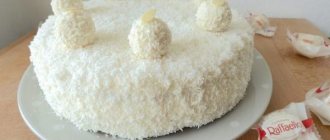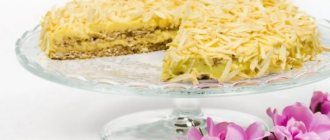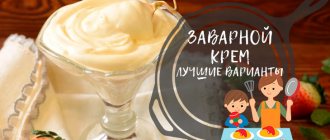Having tried the Crème anglaise recipe, we will continue the experiment without delay and urgently find a use for the tasty liquid. We immediately discard mousse cakes, hours-long baking, complex and day-consuming sweets - I suggest not performing a feat, preparing a dessert that is indecently simple, but worthy of savoring.
We gel it, combine some of it with strawberries, and for beauty and variety of taste, pour it into portioned bowls in layers. After setting, sprinkle with any crispy crumbs (biscuit, waffle, meringue, nut), and finally decorate with colored glazed crumbs and fresh berries with peach slices.
Chilled jelly from Anglaise sauce is tender, unsteady and melting, with a pleasant creamy “tint”. Flavor and color as you wish. Give the strawberry place to expressive blueberries, bitter chocolate, sugary liqueur or a drop of rum. Remember lavender, fragrant with magic. The list of additives is endless and there can be many desserts on a common basis.
Cooking time: 120 minutes / Number of servings: 3-4
Step-by-step preparation
Step 1:
Prepare ingredients for making cream. It is better to weigh all products on scales, especially yolks. 45 grams are the yolks of two large eggs. If you get more weight than in the recipe, then mix the yolks and then measure out the required amount. This will be much more convenient. Or increase the amount of other products in proportion to the weight of the yolks. Vanilla is most often used as a flavoring; I use vanilla sugar with natural vanilla.
Step 2:
Take a saucepan with a thick bottom. Pour milk and cream into it. Add half the amount of sugar and flavoring. For me it's vanilla sugar. You can take natural vanilla and scrape out the pulp and seeds. You can take vanilla extract. Aromatic herbs, cinnamon, coffee, and tea are also good flavoring agents. It is better to choose natural, non-chemical flavors.
Step 3:
Bring the mixture to a boil, but do not boil. As soon as the first bubbles appear, immediately turn off the heat. Cover the saucepan with a lid and let it brew for 15-20 minutes. This is necessary for the flavor to infuse. You don’t have to do this if you have limited time, but it will be much tastier. Some recipes suggest leaving the mixture overnight.
Step 4:
After the allotted time, put the mixture back on the fire to warm it well again. At the same time, stir the yolks with the remaining sugar. There is no need to beat them - just stir until smooth.
Step 5:
Pour a small amount of hot milk mixture into the yolks. Be sure to stir the yolks constantly to prevent them from curdling from the heat. Then pour the mixture with the yolks back into the saucepan.
Step 6:
Place the saucepan on the lowest heat and bring until thickened, stirring constantly. It is most convenient to stir with a silicone spatula - it perfectly collects the product from the walls and bottom. And this is important, because the heat can cause the yolks to stick there and turn into an omelette.
Step 7:
Cook the cream to a temperature of 82°C. At a higher temperature, the yolks will cook and the cream will be spoiled.
Step 8:
If you don’t have a thermometer, check the readiness by checking the fingerprint on the shoulder blade - it should remain clear. It is better not to finish cooking the cream than to overcook it.
Step 9:
As soon as the cream reaches the desired temperature, immediately turn off the heat. Strain it through a sieve into another bowl - this will stop the heating and remove any coagulated whites that were left behind when separating the eggs. This will also remove the flavor if you used something large.
The finished cream can be consumed immediately in this form. It is perfect for drizzling pastries, berries, and desserts. The cooled cream can be used to make other types of creams, ice cream and cakes.
Be sure to wash your eggs before using them, as even seemingly clean shells can harbor harmful bacteria. It is best to use food grade detergents and a brush.
I see an error in the recipe
This is interesting: Potato pancakes, recipe with photo
Burgers
You can prepare original and very tasty buns with Patissier cream. To do this, you will need products in the following ratio:
- For the dough: for 200 milliliters of milk, 1 egg, 100 grams of sugar, 35 grams of butter, a teaspoon of dry yeast, a pinch of vanillin, 2-3 grams of salt and 2.5 cups of flour.
- For the cream: for 0.3 liters of milk, 50 grams of potato starch, 100 grams of sugar, 2 yolks and a little vanillin.
The preparation of such buns takes place in 4 stages:
- First you need to make the dough. To do this, you need to dissolve the yeast in warm milk and wait until it starts working. At this time, melt the butter, and then, pour it into a deep bowl, add salt, egg, sugar, vanillin and grind it all well with a regular fork. Add the prepared mass and flour to the yeast and knead into a homogeneous dough. Leave it to ripen for 1 hour.
- To make the cream, first boil the milk and then add some sugar and vanilla to it. Wait until they are completely dissolved. Separately, grind the yolks with starch and remaining sugar. Then pour some of the hot milk into a bowl and gradually, stirring, add the egg mixture to it. Pour the resulting mass into boiling milk, put it on the stove and cook until thickened.
- Afterwards, knead the dough well, divide it into several parts and roll each of them into an oval-shaped layer. Place a little cream (a couple of teaspoons) in the center of the workpiece and cover it on one side, pressing the edges tightly. Cut the other side of the dough into strips and then fold them up. Place the semi-finished products on a baking sheet, cover with film and leave for 10 minutes.
- Brush the products with beaten egg and place in the oven, preheated to 180 degrees.
A tender golden brown crust will indicate the readiness of the buns.
What is Cream Anglaise?
This cream is one of the brightest representatives of the “good old” European cuisine. It is very reminiscent of regular custard - the same creamy white, smooth, thick. Delicious and easy to make, anglaise contains approximately 210-215 kilocalories per 100 grams.
Creme Anglaise originates from 18th century France. Judging by literary works and films, kings and court retinue (both French and English) loved to feast on such works of confectioners.
Depending on the thickness, anglaise is very good for dressing pies and biscuits, cookies and fruit. It is often used as a sweet sauce for ready-made “confectionery” or as an independent dessert.
What it is?
Crème Anglaise is popularly called vanilla sauce or custard. This popular filling is prepared in 20 minutes and is suitable for both making desserts and serving as an independent dish.
Crème Anglaise is a simple sauce with a sour cream consistency, which consists of yolks (sometimes whole eggs), sugar, full-fat milk, cream and vanilla. As a rule, when warm it spreads, and when it cools, it thickens. Belongs to the category of stirred custards. In other words, it is a custard that is prepared in a deep bowl by boiling milk and yolks.
Custard is a liquid or sauce. The term is widely used among confectioners. Can be used as a separate dessert with the addition of chocolate, cookies and ice cream. But more often it is used as a filling for baked goods (cakes, cakes, eclairs).
Calorie content of foods possible in the dish
- Condensed milk 7.5% fat - 140 kcal/100g
- Milk 1.5% fat - 47 kcal/100g
- Milk 2.5% fat - 54 kcal/100g
- Milk 3.2% fat - 60 kcal/100g
- Milk 3.5% fat - 64 kcal/100g
- Whole cow's milk - 68 kcal/100g
- Sugar - 398 kcal/100g
- Granulated sugar - 398 kcal/100g
- Cream 35% – 337 kcal/100g
- Cream 40% – 362 kcal/100g
- Egg yolks – 352 kcal/100g
- Vanilla sugar - 379 kcal/100g
Calorie content of foods: Milk, Heavy cream, Egg yolks, Sugar, Vanilla sugar
Brioche with cream
Very often, French custard is used to bake baked goods. Here it plays the role of filling. Brioche buns with Patissier cream are very popular all over the world. To make them, you must have the following ingredients on your workbench:
- For the dough: 250 milliliters of warmed milk, ½ kilogram of flour, 60 grams of softened butter and sugar, 21 grams of pressed yeast and 5 grams of salt.
- For the cream: 40 grams of sugar, 20 grams of starch, 250 milliliters of milk, 2 yolks and a little vanilla (or 1 sachet of vanilla sugar).
The cooking process consists of several stages:
- First you need to do the test. To do this, combine the yeast with sugar, add the sifted flour and stir everything well.
- Gradually add all other ingredients. Continue kneading for 20 minutes.
- Place the finished dough in a warm place for 60 minutes.
- At this time, for the cream, grind the yolks with starch. Then dilute the resulting mass a little so that it becomes more liquid.
- Bring the remaining milk to a boil, and then slowly pour it into the egg mixture in a thin stream, stirring constantly. Beat for 3 minutes until the mixture thickens, then cover with cling film and leave to cool.
- Sprinkle the table with flour and roll out the dough on it into a thin layer.
- Coat it with the prepared cream, and then roll it up into a roll.
- Cut the resulting roll into even pieces.
- Place the pieces on a baking sheet so that there is still free space between them, and leave them for 35 minutes to proof.
- Place the semi-finished products in the oven for 40 minutes, preheating it to 160 degrees.
After cooling, the finished brioche can be coated with glaze or the rest of the same cream.
How to make a classic (basic) sauce anglaise
Preparing the cream is quite easy and does not require additional skills or knowledge. For it you need to prepare a small, fairly simple and inexpensive set of products:
- eggs (egg yolks) - 5 pieces;
- milk (at least 2.5-3 percent fat content) – 1.5 cups;
- granulated sugar – 4 tablespoons with a small slide (if you like it sweeter, you can use 5 tablespoons);
- cream (choose a higher percentage of fat content, you can also use confectionery cream - 30 percent);
- vanilla sugar – 1 sachet.
Cooking:
For ease of preparation, it is better to immediately take a deeper container, since we will have to mix all the ingredients in it. The process takes about twenty minutes.
Firstly. Combine milk and cream, add vanilla. We put it on a small fire and quickly remove it at the moment of boiling.
Secondly. Beat eggs and sugar thoroughly until foamy. Don’t bother with a whisk; it’s much faster and better to beat this eggnog with a mixer. Note: yolks beat better than a whole egg.
Third. Carefully, slowly and stirringly, pour a slightly warm mixture of milk and cream into the sweet eggnog. The dish is ready!
This version of the cream is especially popular among the British, which is why it is often called English sauce. But if you want to get a thick cream from the sauce, then place the container with anglaise in a water bath and, stirring, achieve the desired thickness.
Thick anglaise is almost always used for layering cakes, filling eclairs or choux pastries.
This version of cream sauce is the basis for preparing other very tasty fillings and creams. There can be as many variations on the theme of anglaise as you like, it all depends on the addition of various components - coffee, cocoa, rum or citrus essence, etc.
This is interesting: Cottage cheese dessert for a children's party
Basic recipe for custards
Regular custard is made from yolks and milk. It contains the most ordinary products, it is even more surprising how they turn into a delicious mass that makes desserts appetizing. For the basic recipe we need:
- milk – 400 ml;
- fresh eggs - 3 large pieces;
- wheat flour – 35 grams;
- white sugar – 150 grams;
- vanilla sugar – 10 grams.
Preparation:
- We start by carefully separating the yolks from the whites. The yolks will be used for cream, and the whites can be used to prepare another dessert.
- Mix the yolks with flour and sugar until the sugar is completely dissolved.
- Pour the milk into a small saucepan and bring to a boil. Then slowly, in a thin stream, introduce a mixture of yolks, flour and sugar into it. At the same time, mix the mixture with a whisk, preventing the appearance of lumps.
- Set the heat to low and boil the contents of the pan to the desired thickness. Be sure to stir so that our mixture does not burn.
- At the very end, before turning off, add vanillin. Our pâtissière cream is ready to be used to decorate buns, pancakes or cakes.
Some recipes use not vanilla sugar, but a vanilla pod, so it will need to be removed from the base before whipping.
Where is Anglaise used?
The product is mainly used in the confectionery industry, as well as in the creation of baked goods and sweet desserts. When baked, you get caramel cream, and when frozen, you get a unique tasting ice cream. And if you add flour or starch to it, you get a confectionery filling.
Anglaise goes very well with pudding, fruit pie, and is also the main base for making mousses, soufflés and many other desserts. When served, it can be not only cold, but also warm. It is also used as a dressing for pies, buns, and pancakes.
If the main ingredient, milk, is replaced with white wine, you get Savoy sauce with a divine and unique taste, which is the basis of the Sabayon dessert from Italy. By adding whipped cream to the anglaise, then diluted with gelatin, you get a wonderful Bavarian cream. In a word, this product provides a huge field for culinary creativity.
Lemon custard
List of products from which you will prepare “Patissier”:
100 g fine crystalline sugar; 3 yolks; 0.6 l milk; juice of half a lemon; 4 tbsp. spoons of starch; a pinch of vanillin; teaspoon lemon zest; 0.5 teaspoons lemon extract; 2 large spoons of powdered sugar and 200 ml of heavy cream.
Preparation procedure:
- Whisk the yolks and granulated sugar in a saucepan
- Pour in cold milk with diluted starch.
- Add lemon zest and place the bowl on the stove.
- Cook the mixture over medium heat until it becomes thick. Then cool it at room temperature. To prevent a thick film from appearing on the surface, cover the mixture or place a small piece of butter.
- Separately, whip the cold heavy cream and add the powdered sugar.
- Combine the custard mixture with cream, add lemon juice and extract.
- Beat the Patissier again with a mixer.
Before serving, the dessert is well cooled and placed in bowls.
You can use coconut or chocolate shavings for decoration.
Making Creme Anglaise
Before you start the cooking process, read a few tips so that your Anglaise will turn out right:
- Pasteurized milk must be used. You can replace it with cream or use a mixture of these two products;
- The mixture based on the egg-milk component must be heated so carefully as to prevent the yolks from curdling;
- If you want to make ice cream from ready-made creme anglaise, you need to add more sugar and eggs in proportion to milk;
- Hot milk is poured into the yolks gradually, and it must be stirred constantly, otherwise the yolks may curl. To prevent such a sad ending, first pour in a few spoons of warm milk and stir well. Only then, very carefully, with constant stirring, add the rest;
- As a flavoring you can use melted dark chocolate, grated citrus zest, cinnamon, coffee, nuts, vanilla. You can add dried fruits or pralines to the finished product.
Now the recipe for crème anglaise. To create three servings you need:
- Milk – 300 ml;
- Food flavoring “Rum” – 1 ml;
- 3 egg yolks;
- Sugar – 60 g;
The preparation diagram is as follows:
- Milk is combined with flavoring in one container, which is put in the refrigerator for a day to allow the mixture to infuse. Then it is filtered;
- Lightly beat the yolks with sugar. Heat the milk mixture until bubbles appear, then carefully begin pouring it into the yolks with sugar in a small stream, stirring everything regularly with a whisk. The eggs will be tempered. This is the process by which the eggs "acclimate" to high temperatures. Next, you can safely add the rest of the milk, continuing to stir with a whisk;
- Pour the mixture into a saucepan or ladle, set the pan over a low flame and cook, stirring regularly. Bring to a temperature of approximately 79-80 degrees and boil for a minute. This is necessary for sterilization;
- Boil the bushard to a temperature of 84 degrees. If you exceed this value, the eggs will begin to curl. It is better to use a special kitchen thermometer to accurately determine the temperature (under no circumstances use a thermometer or room thermometer for this purpose). But you can determine the degree of readiness with a wooden spoon. If the liquid envelops it and does not flow from the spoon, it means it’s ready. You need to stir the product using gentle movements in the form of the number 8 or the letter Z to distribute the heat evenly throughout the dish. Don’t forget about the edges and bottom, because it is in these places that folding can occur;
- Place the container with the finished product in an ice bath (into a larger container with ice) and stir for another 5 minutes so that it does not thicken. Cool the brew completely by covering the container with cling film and transfer it to the refrigerator, where it can be stored for up to 48 hours.
If the Creme Anglaise is still overcooked and begins to curdle, you need to immediately remove the saucepan from the flame and add a large spoonful of heavy cream into it, then, when the mixture has cooled, immerse it in a blender and stir.
You can make ice cream from the resulting mass. In an ice cream maker, this is done according to the instructions for the device. If you do not have this device, then beat the cooled custard, pour it into a food container with a lid and place it in the freezer. After half an hour, take it out and beat again. Repeat the process 4-6 times. The ice cream will be ready approximately 5-8 hours from the start of freezing.
Creme Anglaise - recipe from Elizaveta Glinskaya
Another option for preparing Creme Anglaise from Lisa Glinskaya, an award-winning pastry chef, winner of the second season of the Master Chef show in Ukraine. It is practically no different from the previous one, but it still has some features. For cooking you need:
- Sugar – 60 g;
- 3 egg yolks;
- Milk – 250 ml;
- Vanilla pod.
The cooking process is as follows:
- Cut the vanilla pod lengthwise and take out the middle, then put it in a saucepan, add milk, add half the sugar (30 g) and put on the flame and bring to a boil;
- Beat the yolks with sugar until white and pour milk into them. Mix everything thoroughly with a wooden spoon or spatula;
- Return the mixture to the milk container and place it in a water bath. Let the delicacy take longer to prepare, but the likelihood of the yolks curdling will decrease;
- We continue to mix everything thoroughly, periodically removing the container. If you exceed the temperature of 85 degrees, the product will curdle. The custard should thicken a little and coat the spoon. This will mean that it is ready and needs to be removed from the water bath.
It can be served hot or cold.
Now you know how to make crème anglaise yourself. With it you will get delicious pastries and wonderful desserts. It all depends only on your skill and imagination.
Cooking a dish step by step with photos
Step 1
We will prepare this custard from milk, egg yolks (you can freeze the whites and then make meringue, for example), granulated sugar, wheat flour (you can try using potato or corn starch as a thickener) and vanilla sugar (a pinch of vanillin is perfect , vanilla extract - a few drops, natural vanilla - on the tip of a knife).
Step 2
In fact, preparing Patissiere cream is much faster than writing a recipe. In a saucepan, combine egg yolks, flour, sugar and vanilla sugar.
Step 3
Mix everything until relatively homogeneous - you can use a mixer or a whisk. It turns out to be such a crumbly mass.
Step 4
Now heat the milk thoroughly - almost to a boil. Add hot milk little by little to the saucepan with the yolk mixture and mix thoroughly. In general, I advise you to pour about half a glass of milk and beat everything with a mixer. This way we won’t leave a single chance for the lumps. Then add the rest of the milk and mix again.
Step 5
The result is a liquid mass whose color resembles condensed milk diluted with water.
Step 6
Place the saucepan on the fire. You can cook this custard on high heat at first, but you need to stir it continuously throughout the cooking process. When the liquid warms up and becomes more than warm, reduce the heat and simmer the cream over low heat. Stir with a whisk all the time so that the cream does not burn or form lumps. The cream should not boil directly, but only gurgle a little with large bubbles. In total, I cooked the cream for about 5 minutes. Patissiere custard is ready when the consistency becomes like thin semolina porridge or condensed milk. Remember that it will thicken even more after cooling.
Step 7
And now a little secret (for those who don’t know): when cooling, a crust can form on the surface of the cream, which is absolutely useless to us. But if you cover the saucepan with a lid, condensation will form and there will be water in the cream. We don't need that either. So we do this: take cling film and cover the cream with it, place it directly on top, letting out the air. Leave the cream in this position until it cools completely.
Step 8
Then we simply remove the film - the cream will not stick to it. The patisserie will thicken nicely - look at the photo. From this quantity of products you get 570 grams of an amazing homemade delicacy.
Step 9
It tastes simply amazing: delicate, smooth, silky and uniform. Quite sweet, by the way (you can try reducing the amount of sugar a little if you find it too sweet).
Now you can prepare all kinds of homemade confectionery with this custard or simply serve it with coffee or tea. Bon appetit, sweet tooth friends!
How to prepare chocolate cream
Absolutely all types of Patissier cream are prepared in the same way. Therefore, you should only familiarize yourself with the classic recipe. Using it and additional ingredients, you can make completely different treats that are similar in consistency, but different in taste, color, aroma, etc.
It should also be noted that by experimenting with the classic method of preparing Patissiere cream, you can diversify your homemade desserts, making them lemon, chocolate, vanilla, milk, etc.
Once all the necessary ingredients for the chocolate Patissiere are ready, you can safely begin preparing it. To do this, egg yolks are separated from the whites and mixed with cornstarch, white sugar and whole cow's milk. After this, whisk the ingredients vigorously and place in a water bath.
Having received a homogeneous and thick mass, remove it from the stove and immediately add broken pieces of dark chocolate and a spoonful of cognac. After the bitter delicacy has melted, whip the cream again, cover with a lid and refrigerate (for 25-28 minutes).
While the cream is cooling, begin processing the heavy cream. Beat them very vigorously until fluffy and airy.
Finally, the finished Patissiere chocolate cream is removed from the refrigerator and mixed with the previously whipped cream. The end result is a very tasty, sweet and thick dessert, which is presented to the table in glass bowls.
If desired, this delicacy can be used to lubricate cake layers intended for making a cake. It should also be noted that brioche buns with Patissier cream are no less tasty. But to prepare such a dessert, you should prepare a rich yeast dough in advance, and then form it into products and bake them in the oven.
